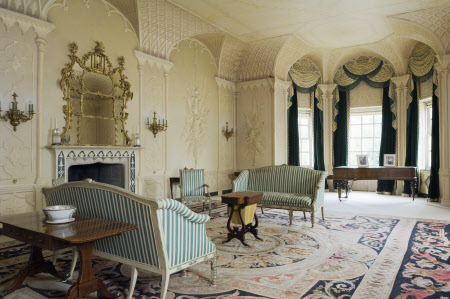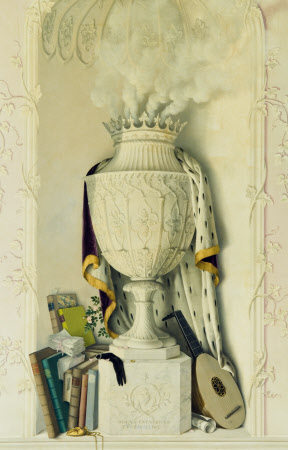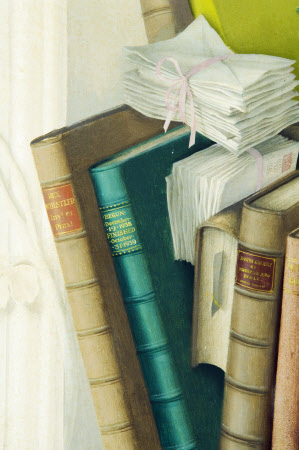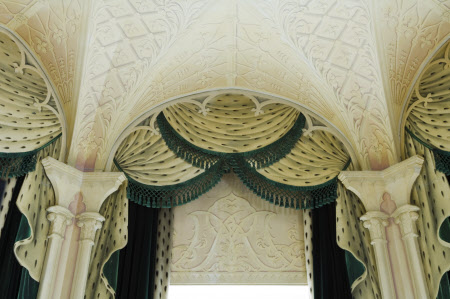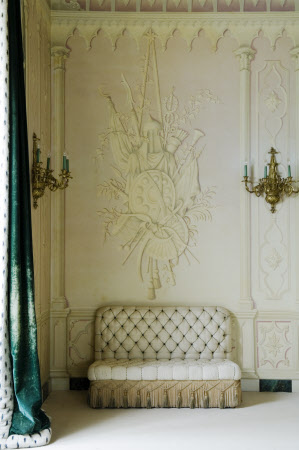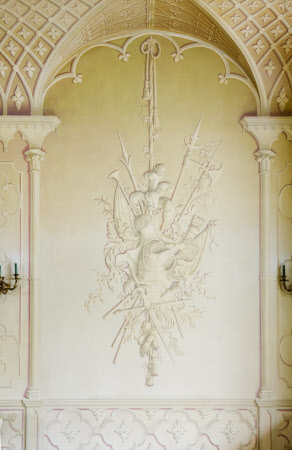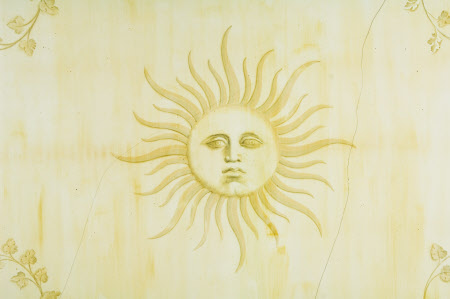The Drawing Room Mural, Mottisfont Abbey
Rex Whistler (Eltham 1905 - Normandy 1944)
Category
Art / Wall paintings
Date
1938 - 1939
Materials
Oil on plaster
Measurements
(180 x 297 x 552 in) 4,572 x 7,544 x 14,021 mm (Height x Width x Length of Room)
Place of origin
Mottisfont Abbey
Order this imageCollection
Mottisfont, Hampshire
NT 770099
Summary
Oil painting on plaster, The Drawing Room Mural, Mottisfont Abbey designed and painted by Rex Whistler (Eltham 1905 - Normandy 1944) with assistance from Victor Bowen (1897-1977) and Percy Stone Willats (1889-1966). Inscribed and dated, high up, next to the miniature paint pot, with a brush still in it, a box of matches: I was painting the Ermine curtain when Britain declared War on the Nazi Tyrants. Sunday Sept 3rd 1939 R.W. And on the spine of the books at the base of the urn: REX WHISTLER INVt. et PINXt. & ·BEGUN· /·December· /·19· 1938/ FINISHED /·October· /·31·1939. A trompe l'oeil decorative scheme. The room was decorated between December 19, 1938 and October 31, 1939. It shows an architectural interior in a 'Gothick' Revival style with several trophy panels, a large smoking urn, draped with ermine - with Latin inscription, simulating as if it is carved into the marble: MAGNA EST VERITAS ET PRAEVALEBIT [Truth is mighty and it shall prevail] - within a niche between the west windows and a ceiling with twisting vines surrounding a central sun.
Full description
Gilbert and Maud Russell purchased Mottisfont Abbey in the summer of 1934, and renovated and re-decorated the entire house. By the summer of 1938, most rooms had been completed, with the major exception being the planned Drawing Room at the west end of the principal floor. Since the house’s major building project in the 1730s, this room had operated as the house’s formal entrance hall. The Russells, however, had re-located the entrance to a former bedroom to the west, allowing the room to be used for entertaining instead. For this to happen, the room was stripped of its 18th-Century panelling to prepare for a new plastered surface of Keen’s Cement to allow for painting. The exposed walls, showing earlier phases of the building, were photographed by H.W. Salmon & Son of Winchester (NT 1954675). In 1937, the Russells commissioned an unknown French decorator to design the scheme with the work progressing as far as an architectural model. However, this scheme was rejected and instead they invited Rex Whistler, who had recently completed the Dining Room scheme at Plas Newydd in Anglesey (NT 1175991), to complete the room’s decoration for them. Whistler had also completed work for Maud Russell’s childhood friends, Duff and Diana Cooper, and she likely knew him socially through Cecil Beaton. Maud was involved throughout the commission, actively commenting on Whistler’s ideas and challenging them – not his usual experience of a client. Maud began by researching into Gothic tapestries to help develop their ideas along a theme celebrating the Abbey’s medieval history. In contrast, Whistler began imagining the possibilities of a scheme based on the surviving medieval cellarium below with suggestions for a trompe l’oeil spiral staircase in one corner of the room and golden skulls. Maud’s diary records how much she enjoyed spending time with Whistler discussing the design, writing of the experience: “I enjoy seeing him scribble his ideas on paper, holding his pencil so strangely and clutched half way down between his second and third fingers. His pencil drips ideas.” Clearly these were two contrasting views of the Gothic, and Whistler had to rein in some of his more fanciful ideas and come closer to his patron’s vision. Eight of the original drawings for the room are in the collection at Mottisfont (NT 769745, 769747-769751, 770132, 770133). They show how Whistler’s ideas developed, with his initial proposals to include romantic landscape views overruled by Maud’s preference for trophies. The final decision is recorded in her diary on 7 May 1939: “Rex had chalked in some delicious scenes – ruins, stages, bowed trees to tempt me and I was tempted. But I returned again to trophies”. The bulk of the scheme’s design was painted in grisaille on a pink background. The cornice is formed of machicolations which is then supported by painted columns and pedestals. In between these, a total of seven trophies were painted, also all in grisaille. On the south wall, flanking both sides of the bay window they represent, to the east, music and to the west, chase. On the south end of the west wall, is a trophy representing priestcraft – perhaps recalling the house’s origin as a priory. On the north and east walls are four further trophies, all of a martial character. Despite this difference of opinion, the scheme retains much of Whistler’s original vision of a room inspired by the 18th-century Gothic revival and playing on the house’s 13th-century origins. Elements such as the faux ermine-lined curtains (NT 769997) and the Rococo-style mirror over the fireplace (NT 769324) were consistent elements of his design from the very beginning. Work to paint the scheme began in earnest in early 1939. Whistler was assisted by Victor Bowen (1897-1977) who had worked with him on the scheme at Plas Newydd, and seems to have also employed Percy Stone Willats (1889-1966) who worked for Lenygon and Morant. Bowen and Willats were responsible for painting much of the repeated patterns, such as the cornice and much of the Gothic tracery elements. Whistler himself, concentrated on the trophies, the urn, the marbling and the pelmets. The trompe l’oeil urn, undoubtedly the centrepiece of the scheme, seems to have been painted by Whistler in Maud’s absence. She later re-called how he was delighted to have brought some colour into the scheme, and she couldn’t bring herself to wash it out. He soon added billowing smoke from the urn, a playful joke on her apparent dislike of bonfires. It is likely that Maud chose the Latin inscription – Magna est veritas et Praevalebit – ‘Truth is mighty and it shall prevail’. A defiant statement on the eve of the Second World War, and a time when she was acutely aware of the threats faced by her Jewish relatives in Germany. Whistler added further items to accompany the urn: a mandolin to represent Maud’s love of music, books for her love of reading, and her wedding ring and love letters to Gilbert. Rex’s brother Laurence, while being a strong critic of how he believed Maud had treated his brother and restricted his vision, believed the urn to be his greatest work of trompe l’oeil. It was also Whistler’s final major room scheme as he was killed on active service with the British Army in July 1944. Poignantly, he left a hidden message above the cornice to the left of the southern bay window. “I was painting this ermine curtain when Britain declared war on the Nazi tyrants. Sunday September 3rd. R.W.” He finally finished the scheme in early November 1939. Maud Russell wrote in her diary: “…Rex finished the room and left. He left quickly and I felt as if a loved person had gone for ever or as if part of the house I was living in had been suddenly pulled down.” Although Whistler may have been disappointed with Maud Russell’s rejection of some of his ideas, much of the scheme is his and can be traced back to his initial sketched ideas. This includes the pinkish background colour of the painted wall surfaces and also the ten wall light fittings (NT 769622) and the faux-ermine lined curtains, both of which he designed. Photographs show one further element - a light fitting in the southern bay window - however, the paper mock-up was rejected by Maud Russell. Despite this, surviving correspondence shows that she had hoped he would return after the war to design furniture for the room, a request he agreed to. However, his death meant that this final element of the room was never completed.
Provenance
Commissioned by Gilbert and Maud Russell for the Drawing Room at Mottisfont Abbey in 1938. Transferred to the National Trust by Maud Russell with Mottisfont Abbey and Estate in 1957.
Makers and roles
Rex Whistler (Eltham 1905 - Normandy 1944) , publisher Victor Bowen (1897 - 1977), publisher Percy Stone Willats (1889 - 1966), publisher
References
Whistler and Fuller, 1960: Laurence Whistler and Ronald Fuller. The work of Rex Whistler. London: Batsford, 1960., pp.11-13; Figs. 26-29. Russell 2017: Emily Russell (ed.), A Constant Heart; The War Diaries of Maud Russell 1938-1945, Wimborne Minster, 2017, pp.38-76. Frater 2024: Nikki Frater, Rex Whistler; The Artist and his Patrons. London, 2024, pp.163-172 Whistler, 1985: Laurence Whistler. The laughter and the urn: the life of Rex Whistler. London: Weidenfeld & Nicolson, 1985. Cecil & Cecil 2015: Hugh Cecil and Mirabel Cecil, Rex Whistler at Mottisfont Abbey, Swindon, 2015 Cecil & Cecil 2012: Hugh Cecil and Mirabel Cecil, In Search of Rex Whistler: His Life & Work, London, 2012, pp.182-191.
